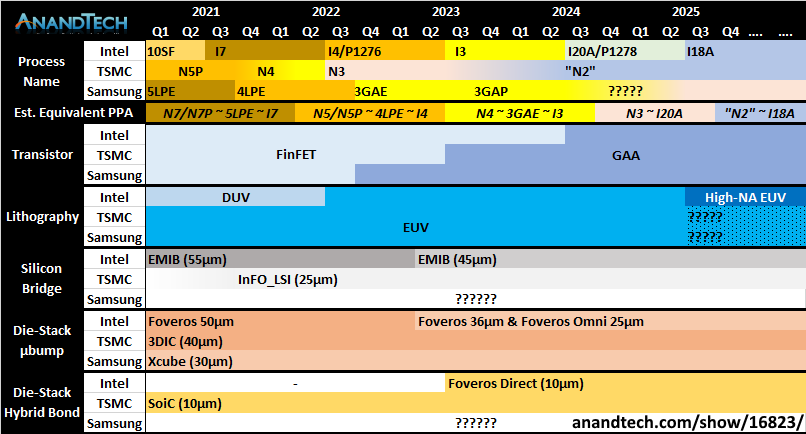Intel's Process Roadmap to 2025: with 4nm, 3nm, 20A and 18A?!
by Dr. Ian Cutress on July 26, 2021 5:00 PM ESTCustomers Customers Customers
As a roadmap announcement today, the focus isn’t so much on the customers but on the technology. Because Intel is moving into a phase where it expects its IFS offerings to compete against the established players, it has to consider its disclosures with respect to both its internal use and any external interest, which is a new concept for the company – at least on this scale compared to its previous foundry efforts.
Intel CEO Pat Gelsinger, in the company’s Q3 financial call last week, was keen to point out that they already have a large hyperscaler customer signed up for their next generation packaging technology, however today there would appear to also be another customer in the mix. Now we assume that Intel’s Foundry Services is talking to 100s of chip companies, big and small, but it doesn’t take much to sign an NDA to start to talk – what will be interesting is when customers start making commitments to using Intel’s facilities, and if any of those are volume orders.
As part of the announcement today, Intel held a little bit back from us, saying that they are saving some of the details specifically for the event that is going on as we publish this piece. All we know is that our draft press release has a big yellow bar that says ‘[customer news]’ on it, right next to Intel’s 20A process node details.
For reference, Intel 20A is a 2024 technology using first generation Gate-All-Around transistors, marketed as RibbonFETs, as well as backside power delivery, marketed as PowerVias. At this time Intel expects to have second/third-generation EMIB available as well as fourth-generation Foveros Direct. So if a customer is already committing to Intel 20A, there’s going to be a lot of potential here.
When the announcement is made, we will update this news article.
To conclude, Intel maintains that these roadmaps will showcase a clear path to process performance leadership* by 2025. It’s a tall order, and the company has to execute better than it has in recent memory - but that’s kind of why the company has rehired a number of former Intel experts and fellows in research, product design, and execution.
*as measured by performance per watt at iso-power
Here's a secondary comparison chart (compared to the one on page one) with all three main foundry offerings listed in each of the main segments that Intel has discussed today.











326 Comments
View All Comments
s.yu - Tuesday, July 27, 2021 - link
So...NA 0.33 is f/3, NA 0.55 is f/1.82?dsplover - Tuesday, July 27, 2021 - link
Hope it happens, more choices for us since Intel has only had some i5’s worth buying in the last 2 years.Single Core scores got me interested again. But marketing hype on TDP and nm size is still a tad too high compared to AMD.
I like the negative -nm response. Humor and competition make me happy.
eldakka - Tuesday, July 27, 2021 - link
" Intel believes it can follow an aggressive strategy to match and pass its foundry rivals"Isn't that exactly what caused their failures with 10nm? The blame for the repeated delays was usually put on them being too agressive with their 10nm shrink, attempting too big reductions in feature sizes, increases in density, etc.
whatthe123 - Wednesday, July 28, 2021 - link
That's true but it was also because they were still ahead of everyone else with 14nm so they continued shooting for unrealistic goals on 10nm instead of just accepting the density loss and shipping something, which is basically what they've done with their SF/ESF updates. They also weren't willing to eat margins to ship products and enjoyed huge profits for a long time.If they accept the costs and react fast to failing strategies then maybe they can actually ship something closer to TSMC's timeline instead of being years behind. Either way they have to be aggressive considering TSMC is still improving.
Oxford Guy - Wednesday, July 28, 2021 - link
The word aggressive signals desperation in this context.mode_13h - Thursday, July 29, 2021 - link
Aggressively pursuing density can also serve greed, since it means more dies per wafer -> bigger profit margins. I think this is the more plausible explanation, because Intel had a comfortable lead at the time they were initially designing their 10 nm process.Heh, I feel sorta weird for having to point that out to you.
Oxford Guy - Tuesday, August 3, 2021 - link
Apples and oranges.Peskarik - Wednesday, July 28, 2021 - link
By 2025 most will not give a s about some processorsPeskarik - Wednesday, July 28, 2021 - link
naming should be more positive, more inventive and more inclusiveunicorn
duecorn
tripplecorn
fourcorn
and, as apotheosis, hornycorn
GeoffreyA - Friday, July 30, 2021 - link
I doubt whether the Censorship Department at Intel HQ will let the last one through.